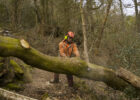The sculpted new cafe which has been developed to an unique design was opened officially on the 18th of March by Lord Mervyn Davies, Lady Jeanne Davies of Abersoch and Gareth Wyn Edwards, Chair of the John Andrews Charitable Trust.
The objective of the café redevelopment was to replace the failing C20 conservatory with a visually striking and environmentally sensitive cafe. A key aim was to provide a fully equipped kitchen to improve efficiency, achieve better working conditions for staff and create more space for seating and events to increase footfall and income. It was also important that the new café connected into and complemented the historic Grade II* listed mansion built in 1856-57 for Lady Elizabeth Love Jones-Parry as a Dower House by the Bangor-based architect Henry Kennedy. As the oldest art gallery in Wales, it is perhaps not surprising that the trustees of the charity chose to think about the redevelopment in a creative way like the artists whose work they display in the gallery. The result is an artist-led solution that combines the requirements for a larger café with site-specific art.
In developing the design the artist MatthewSanderson researched influences in society and architectural precedent at the time the original neo-Gothic mansion was built. It was a period when the nation was gripped with scientific fascination, obsessive exploration, collecting and interpretation into the decorative arts: Charles Darwin’s book, ‘Onthe Origin of Species’, was published in 1859 and his contemporary Ernst Haeckel, the marine biologist and artist, was discovering, illustrating and naming thousands of new species.
The sculpted café is inspired by the site’s historical precedents and the adjacent marine life present today. The beautiful southeast-facing Llanbedrog bay is part of a Special Area of Conservation, host to many species, some of which are special and unique to the area. One such organism, the sea urchin is the inspiration for the eleven-metre-wide, self-supporting structure. The outer shell is the most dramatic element of the design with a colony of 89,000 ‘acorn barnacles’, individually punched and pressed components,welded to their subframe that scatter natural light to minimise internal solar gain. Their highly recycled marine grade 316 stainless steel material is resistant to the chemical and physical weathering present in this coastal location.
Within the urchin structure, a central ‘oculus’ spills natural light into the space below and opens to passively ventilate the café during warm weather. The funnel-shaped chandelier is a separate but integral sculpture inspired by the microscopic zooplankton ‘Litharachnium Tentorium’. 12 sculptural beams that follow Fibonacci’s spiral radiate from the occulus to meet equivalent columns that are joyfully connected to four-pointed arches that echo the style of the Gothic house. Each arch
frames a portal view to the surrounding coastal and woodland views.
The project brings other enhancements to the centre, including the creation of new toilet facilities within the historic mansion approached from the café via an open colonnade allowing flexible and fully accessible use of the whole centre.
Click here to view a film documenting the development





